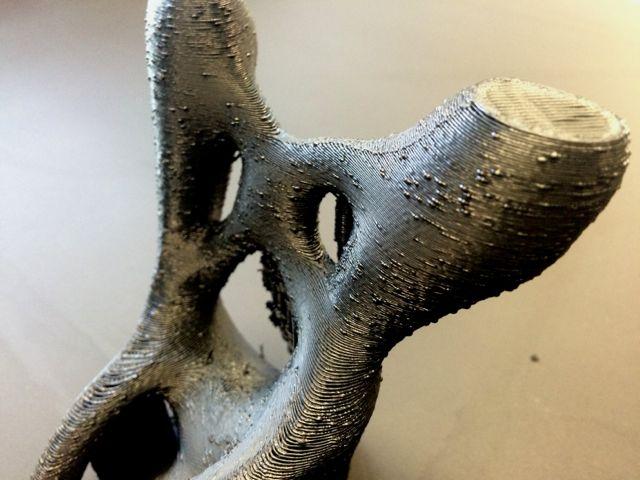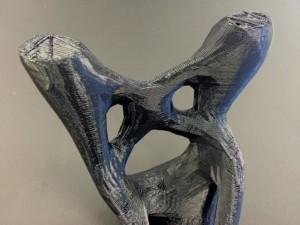 Some of the most helpful 3D printing information can seem boring, but keep in mind that this kind of information may greatly benefit your own 3D printing experimentation. One of these issues is how to improve print quality when you plan to test print a large design at a much scaled-down size. Many scaled-down objects don’t print well, and in Morgan Hamel’s case, there was a problem with “tiny globs of filament dotting the surface of the print.” Thankfully, Hamel figured out how to rectify the problem in Autodesk Meshmixer, and has decided to share this with us so we can have better quality scaled-down prints that are closer to emulating the larger design. This is also a nice little review of 3D printing 101: STL file basics for anyone just getting started with the technology.
Some of the most helpful 3D printing information can seem boring, but keep in mind that this kind of information may greatly benefit your own 3D printing experimentation. One of these issues is how to improve print quality when you plan to test print a large design at a much scaled-down size. Many scaled-down objects don’t print well, and in Morgan Hamel’s case, there was a problem with “tiny globs of filament dotting the surface of the print.” Thankfully, Hamel figured out how to rectify the problem in Autodesk Meshmixer, and has decided to share this with us so we can have better quality scaled-down prints that are closer to emulating the larger design. This is also a nice little review of 3D printing 101: STL file basics for anyone just getting started with the technology.
 Let’s begin with the STL file. This file stores the essential 3D design data that will be sent to your 3D printer. These files break a 3D object’s surface into many little triangles that constitute the object’s surface geometry. When you convert a CAD file to an STL file, this is exactly what is happening. The surface geometry of an object is noted in the new file by all of those little triangles. The more triangles in a part determine that the surface’s curves will be smoother. But this also means that the file size will be larger, and slicing and build times will be longer. If a part has fewer triangles it will slice and print faster, but the curves will not have that smooth quality.
Let’s begin with the STL file. This file stores the essential 3D design data that will be sent to your 3D printer. These files break a 3D object’s surface into many little triangles that constitute the object’s surface geometry. When you convert a CAD file to an STL file, this is exactly what is happening. The surface geometry of an object is noted in the new file by all of those little triangles. The more triangles in a part determine that the surface’s curves will be smoother. But this also means that the file size will be larger, and slicing and build times will be longer. If a part has fewer triangles it will slice and print faster, but the curves will not have that smooth quality.
Are you following so far? More triangles = smoother surface. In Hamel’s case, a very large (443.13 x 503.32 x 434.38 mm) file was scaled down by 25% and the original large file had 103,970 triangles in it. When the size was scaled down, the same number of triangles remained, resulting in the “tiny globs of filament” dotting the print’s surface. Why does this happen? Because as the printer was processing all of the triangles, a little extra filament would ooze out when the printer paused at certain vertices. To avoid this, Hamel reduced the number of triangles in the design so the printer would not use extra filament, forming blobs.
 There’s a 3D Hubs tutorial about the same triangle reduction method Hamel describes, and you can go here to see exactly what was done in the free program Autodesk Meshmixer to fix the problem. In summary, you can click “Edit” and “Reduce” once you’ve imported your object in Autodesk Meshmixer, then select “Triangle Budget” from the drop-down menu next to “Percentage.” Here you have the choice to use the Tri Count slider, or you can double-click the number and select a specific number of triangles to input into the model’s design.
There’s a 3D Hubs tutorial about the same triangle reduction method Hamel describes, and you can go here to see exactly what was done in the free program Autodesk Meshmixer to fix the problem. In summary, you can click “Edit” and “Reduce” once you’ve imported your object in Autodesk Meshmixer, then select “Triangle Budget” from the drop-down menu next to “Percentage.” Here you have the choice to use the Tri Count slider, or you can double-click the number and select a specific number of triangles to input into the model’s design.
That’s really all there is to it. Hamel cut the amount of triangles down by half, and got rid of the blobs while retaining the object’s smooth surface. See? I told you it was worth hanging in there through this seemingly boring topic. Now you can improve scaled-down prints by simply using a couple of key functions readily available in Autodesk Meshmixer. Discuss this article in the Autodesk Meshmixer forum thread on 3DPB.com.
Subscribe to Our Email Newsletter
Stay up-to-date on all the latest news from the 3D printing industry and receive information and offers from third party vendors.
You May Also Like
3D Printing Unpeeled: Biofuel Waste to Filament & Sustainable Photopolymers
I can’t ever remember a day with so many potentially high impact news stories have come out. In one story, we all know that there are problems with the safety...
Finnair Hires AM Craft to 3D Print Plastic Parts for Aircraft Interiors
Riga-based AM Craft, a supplier specialized in 3D printing aviation components and certified under EASA Part 21G, announced a significant achievement today. The company will assist in upgrading Finnair’s A320...
3DPOD Episode 198: High Speed Sintering with Neil Hopkinson, VP of AM at Stratasys
Neil Hopkinson, a pioneering 3D printing researcher, played a pivotal role in developing a body of research that is widely utilized today. He also invented High Speed Sintering (HSS), also...
3D Printing Webinar and Event Roundup: May 12, 2024
Webinars and events are picking up in the AM industry this week! ASTM International continues its Professional Certificate Course and Stratasys continues its advanced in-person trainings, while 3D Systems is...

































